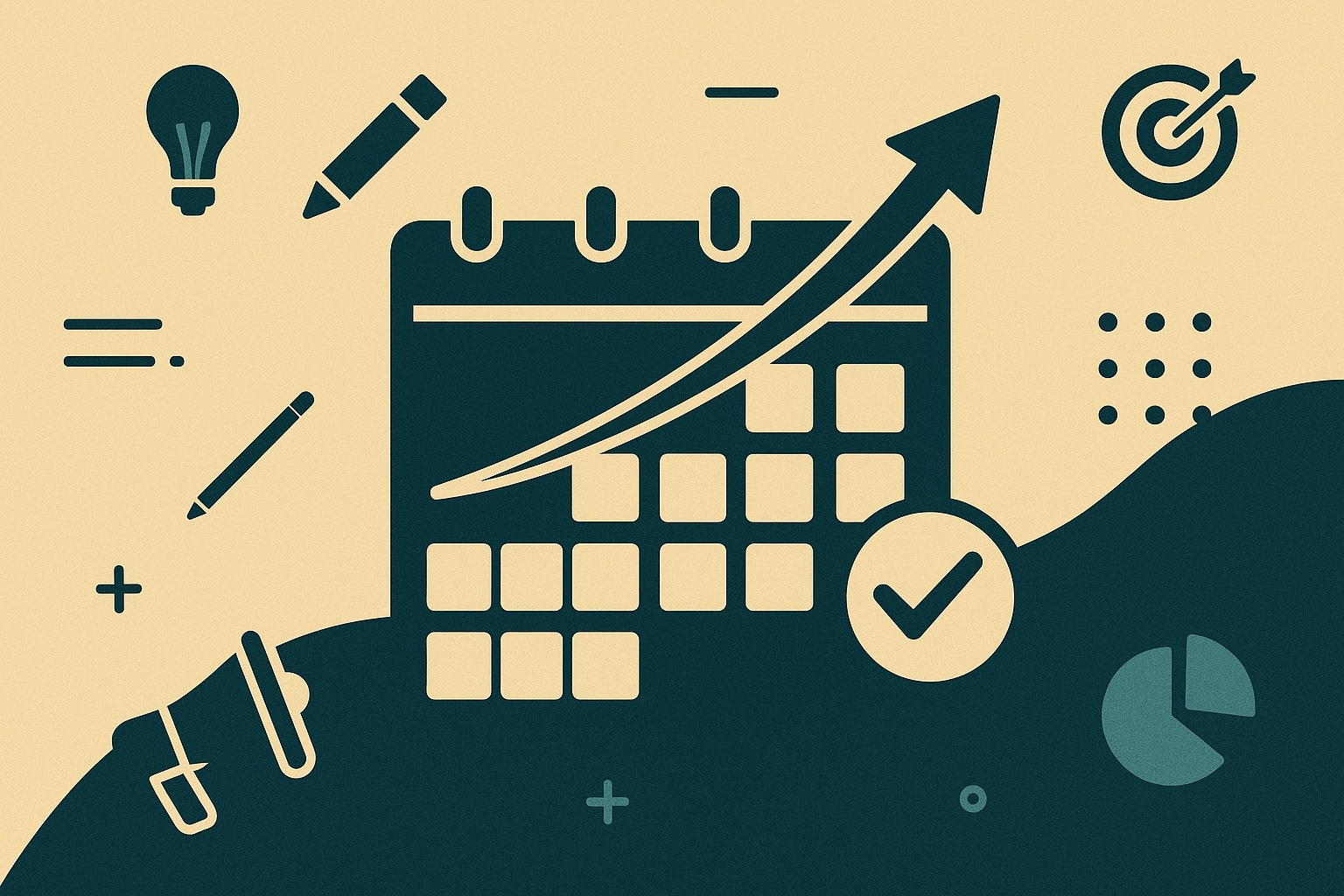
For a lot of business owners, business growth is the goal. It’s a sign of success, a sign that you’re moving in the right direction. But, not all growth is created equal. You might be pleased to see a sudden spike in sales or customer acquisition – and these are certainly impressive in the moment – if you want long-term business success, you need to focus on sustainable growth. This type of business growth is steady, strategic and more likely to continue well into the future. It’s all about finding the maximum growth rate that your business can sustain, without having to increase financial support.
To achieve this, you need to identify and track the business growth metrics and revenue growth indicators that give you an insight into financial health, customer behaviour and operational efficiency, amongst other things. With this information, it’s a lot easier to achieve sustainable business growth.
Allow our Fractional C-Suite to help you put a Business Growth Plan in place; learn more today!
What is Sustainable Business Growth?
When we talk about sustainable business growth, we’re talking about a business’ ability to expand steadily without impacting its financial stability, culture or long-term goals. Instead of monitoring business performance and hoping to see rapid growth at any cost, sustainable business growth focuses on supporting continued, ongoing growth on a long-term basis. When you’re focusing on sustainable growth, you need to prioritise building strong relationships with customers, and not just securing as many one-off buyers as possible. You need to balance operational efficiency alongside business growth, and genuine profitable revenue over metrics that simply make you look good to others.
Why Business Growth Metrics Matter
Key Performance Indicators (KPIs), or key performance metrics, are quantifiable pieces of data that reflect how well your business is performing in certain areas. They’re an important part of monitoring business performance, helping you to determine whether or not you’re meeting objectives, staying efficient and that your business is heading in the right direction. Here’s why you need to monitor business growth metrics:
- Get Performance Insights – Key metrics give you real-time feedback on how your strategies and campaigns are working, highlighting where improvements or adjustments could be made.
- Boost Stakeholder Transparency – It’s important to be open and honest with stakeholders, especially when it comes to the success of a business. Stakeholders want to know that the business is doing well, and key metrics provide proof of that.
- For Continuous Business Improvement – Identifying gaps in your growth or performance early gives you a chance to make improvements before minor issues turn into much bigger problems.
Essential KPIs for Businesses to Track
Though every business is unique, there are some business growth metrics that apply across the board, which every business should be tracking. These performance and revenue growth indicators offer a detailed view of your business’ financial health, marketing effectiveness, customer satisfaction and operational efficiency.
- Revenue and Profit – When you’re monitoring business performance, you need to look at your total income and how much you have left after your expenses. This is your revenue and profit, and they give you an insight into the business’ financial performance. High revenue with low profit could be a sign of inflated costs, poor pricing strategy or operational inefficiencies. But, consistent profit growth is a sign of a healthy, scalable business.
- Cash Flow – You need to know how much money is flowing in and out of your business, as this is a key revenue growth indicator. Positive cash flow means that your business earns more than it spends, giving you the flexibility to invest, pay employees and cover operational costs. Even a profitable business can struggle if cash flow isn’t managed well, making this one of the essential KPIs for businesses.
- Customer Acquisition Cost (CAC) – This is the average cost of gaining a new customer, including marketing and sales expenses. For sustainable growth monitoring, you need to track CAC, as a high CAC can eat into your profits and shows that your marketing, sales and advertising efforts could need tweaking. The goal is to lower your CAC over time, making it more affordable to gain new customers, whilst also increasing the value each customer brings to your business.
- Customer Lifetime Value (CLV) – This is the total revenue you can expect from a customer over the entire duration of your relationship. When your CLV is higher than your CAC – meaning a customer is bringing more money to the business than you spent acquiring them – you’re generating long-term value from your customers. This business growth metric also highlights the importance of retention strategies, upselling,and delivering a consistently great experience that keeps customers coming back.
- Conversion Rates – When you’re monitoring business performance, you need to look at conversion rates. This is the percentage of people who take a desired action, such as making a purchase on your website, signing up for an email list or requesting a demo of your service. Good conversion rates show that your marketing, website and sales funnels are working well. But, low conversion rates could mean there’s an issue somewhere. For example, that your messaging isn’t relevant to your target audience or there’s an issue with the user experience.
- Employee Productivity – Sustainable growth monitoring means looking at employee productivity, and the output or value generated by each member of your team. This is often measured in revenue per employee or deliverables completed in a set time period, but it varies depending on the type of business you have. By tracking employee productivity, you can identify whether your team is working efficiently or if improvements need to be made. It also helps you to spot areas where training, tools or workflow improvements may be needed to make employees more efficient.
- Customer Retention Rate – Customer retention rate refers to the percentage of customers who continue to buy from you over a given time period. Acquiring new customers tends to be more expensive than keeping existing ones, which is why it’s important to keep loyal customers coming back for more. High customer retention rates are a sign of customer satisfaction and loyalty, both of which are essential for long-term growth and profitability.
- Gross Margin – This is the percentage of revenue that remains after you’ve covered the cost of goods sold. A healthy gross margin gives you money to reinvest in business growth, whether that’s expanding your team, ramping up your marketing efforts or focusing on innovation. If your margins are shrinking, it’s a sign that you might need to review pricing, make changes to your supply chain or prioritise cost control.
- Website Traffic – Looking at your website traffic is a big part of monitoring business performance, as it tells you how many people visit your site daily, and how many are visiting for the very first time. This information gives you an insight into your brand visibility, digital presence and how far your marketing actually reaches. High traffic from new users shows that your outreach efforts are working, while returning users suggest brand interest or engagement.
- Net Promoter Score (NPS) – NPS tells you how likely your customers are to recommend your business to others, and it’s measured on a scale from 0 to 10. It’s one of the essential KPIs for businesses as it’s an indicator of customer satisfaction and loyalty. High scores mean customers love what you have to offer, and they’re likely to spread the word and tell others. Low scores highlight areas for improvement in your product, service or experience.
Tracking essential KPIs for businesses isn’t just about having data, it’s about using that data to make smarter business growth decisions, refine your strategies and keep your business moving in the right direction. There’s no shortcut to sustainable business growth, but monitoring business performance and looking at revenue growth indicators gives you a unique insight into where changes can be made, helping you to position yourself for sustainable success for years to come.
Sustainable business growth doesn’t happen overnight, nor does it happen on its own. To truly evolve as a business and achieve long-term, ongoing growth, you need to track key data points and constantly refine your strategies, highlighting areas for improvement or metrics that are falling short. This can be a big undertaking, but you don’t have to do it alone. With the help of Profici, sustainable business growth is within reach. Get in touch to find out more.
Latest Posts
-

Outgrown Your Internal Team? How Fractional Executives Can...
Seeing your business grow is hugely exciting, but growth doesn’t happen on its own. Growth...
-

The Rise of Fractional C-Suites: Why 2025 is...
After many, many years, the way businesses are building their executive teams is changing. With...
-

Why Your Business Needs a 12-Month Marketing Blueprint...
Growing a business isn’t easy, let alone one that grows into a sustainable success. There’s...
-

How April’s National Insurance Rises Impacts Your Business...
On the 6th April, a change took place that’s going to affect employers across the...
